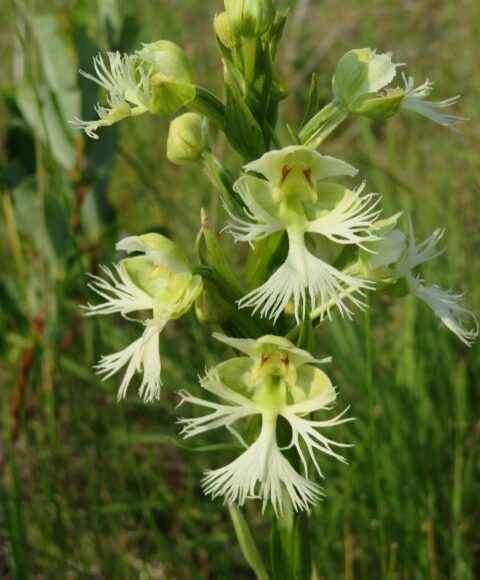Dawson Trail Dispatch, written by Norm Gregoire, July 2022
Page 8 https://issuu.com/dispatch222/docs/dawson_trail_dispatch_july_2022
There is an orchid that grows in Southeastern Manitoba that is found nowhere else in Canada. This orchid depends on one of the worlds rarest ecosystems, the tall-grass prairie, to grow in. This orchid’s Manitoban population depends on only two known pollinators, uncommon species of sphinx moths. They depend on you and I for protection, ensuring that the next generation will be able to enjoy the beauty of this species at risk for years to come.
Western prairie fringed orchids are special. This is the reason I have chosen to cover them first in this species at risk column. July is the month when western prairie fringed orchids are in bloom. What a bloom it is! Multiple, white flowers that are deeply fringed arrange themselves along the upper stem. There are usually 5-7 thin leaves scattered along this stem. Once fully grown the plant can range from 40-90 cm in height, making it a real standout.
Although they are admired by many orchid enthusiasts, more often than not, pollinators seem to pass them by. Partly due to their complex flower heads, only two known pollinators exist for this orchid in Manitoba. These sphinx moths are attracted to the orchids at night when the flower releases its fragrance. The moth will use its proboscis that is long enough to get at the nectar. While doing this, the moths head which is critically, just the right size, will pick up pollen to bring to the next orchid. Such complex pollination needs are one of the reasons that western prairie fringed orchids are considered endangered.
Some of the threats the western prairie fringed orchid faces are more commonplace in regard to all our species at risk in the tall-grass prairie, such as habitat loss. Suppression of fire, low genetic diversity and the altering of wetlands all play a role in the decline of this orchid.
So, what is being done to protect such an incredible species? The Manitoba-based population is found in and around the Manitoba Tall Grass Prairie Preserve in the Rural Municipality of Stuartburn. In fact, the discovery of western prairie fringed orchids in the late 80’s was one of the reasons for the establishment of the preserve. Preserve staff and other conservation groups work hard to implement land management best practices as well as conduct annual surveys to keep track of this magnificent flower.
Generations of locals have been key to allowing the orchid to persist through agricultural practices such as grazing and haying. Community members have always loved the wildness of the tall-grass prairie and have always wanted to do what is best for their family and future generations, and that includes being a steward for the land. Funding has now been made available for community members to be aided in the preservation of this important area in the form of the Stewardship Credit Pilot Program. In this incentive program payments are paid out to property owners who are lucky enough to own some of the last bits of tall-grass prairie. Additional payments are made if you are one of perhaps only a few dozen landowners across Canada who have western prairie fringed orchids. Preserving the quality of this habitat can be a win-win situation for both at-risk species and community members!
If anyone is interested in learning more about western prairie fringed orchid or what you can do to help, please feel free to contact me at sarcommunityliaison@gmail.com

